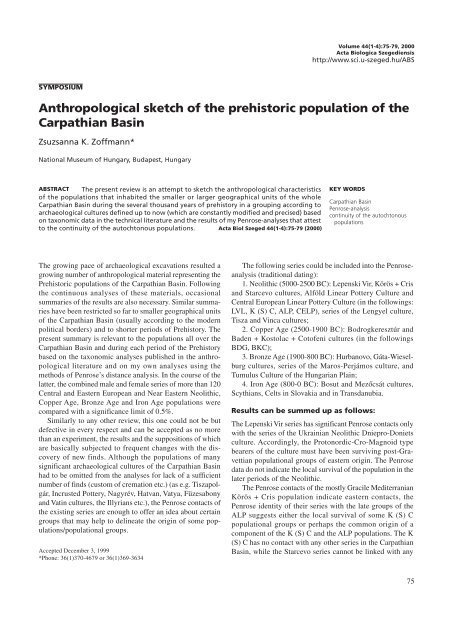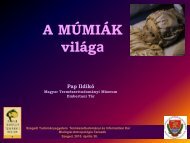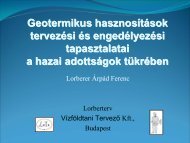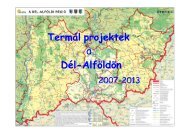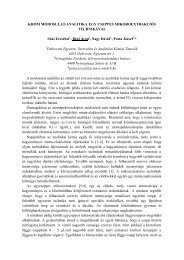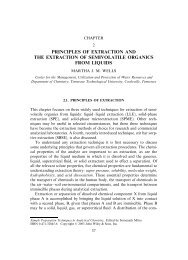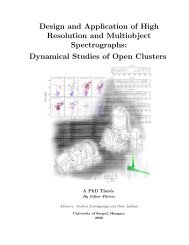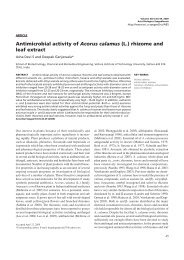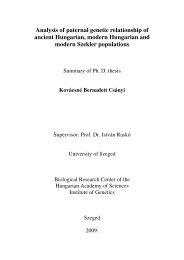Anthropological sketch of the prehistoric population of the ...
Anthropological sketch of the prehistoric population of the ...
Anthropological sketch of the prehistoric population of the ...
Create successful ePaper yourself
Turn your PDF publications into a flip-book with our unique Google optimized e-Paper software.
SYMPOSIUM<br />
National Museum <strong>of</strong> Hungary, Budapest, Hungary<br />
Volume 44(1-4):75-79, 2000<br />
Acta Biologica Szegediensis<br />
http://www.sci.u-szeged.hu/ABS<br />
<strong>Anthropological</strong> <strong>sketch</strong> <strong>of</strong> <strong>the</strong> <strong>prehistoric</strong> <strong>population</strong> <strong>of</strong> <strong>the</strong><br />
Carpathian Basin<br />
Zsuzsanna K. Z<strong>of</strong>fmann*<br />
ABSTRACT The present review is an attempt to <strong>sketch</strong> <strong>the</strong> anthropological characteristics<br />
<strong>of</strong> <strong>the</strong> <strong>population</strong>s that inhabited <strong>the</strong> smaller or larger geographical units <strong>of</strong> <strong>the</strong> whole<br />
Carpathian Basin during <strong>the</strong> several thousand years <strong>of</strong> prehistory in a grouping according to<br />
archaeological cultures defined up to now (which are constantly modified and precised) based<br />
on taxonomic data in <strong>the</strong> technical literature and <strong>the</strong> results <strong>of</strong> my Penrose-analyses that attest<br />
to <strong>the</strong> continuity <strong>of</strong> <strong>the</strong> autochtonous <strong>population</strong>s. Acta Biol Szeged 44(1-4):75-79 (2000)<br />
The growing pace <strong>of</strong> archaeological excavations resulted a<br />
growing number <strong>of</strong> anthropological material representing <strong>the</strong><br />
Prehistoric <strong>population</strong>s <strong>of</strong> <strong>the</strong> Carpathian Basin. Following<br />
<strong>the</strong> continuous analyses <strong>of</strong> <strong>the</strong>se materials, occasional<br />
summaries <strong>of</strong> <strong>the</strong> results are also necessary. Similar summaries<br />
have been restricted so far to smaller geographical units<br />
<strong>of</strong> <strong>the</strong> Carpathian Basin (usually according to <strong>the</strong> modern<br />
political borders) and to shorter periods <strong>of</strong> Prehistory. The<br />
present summary is relevant to <strong>the</strong> <strong>population</strong>s all over <strong>the</strong><br />
Carpathian Basin and during each period <strong>of</strong> <strong>the</strong> Prehistory<br />
based on <strong>the</strong> taxonomic analyses published in <strong>the</strong> anthropological<br />
literature and on my own analyses using <strong>the</strong><br />
methods <strong>of</strong> Penrose’s distance analysis. In <strong>the</strong> course <strong>of</strong> <strong>the</strong><br />
latter, <strong>the</strong> combined male and female series <strong>of</strong> more than 120<br />
Central and Eastern European and Near Eastern Neolithic,<br />
Copper Age, Bronze Age and Iron Age <strong>population</strong>s were<br />
compared with a significance limit <strong>of</strong> 0.5%.<br />
Similarly to any o<strong>the</strong>r review, this one could not be but<br />
defective in every respect and can be accepted as no more<br />
than an experiment, <strong>the</strong> results and <strong>the</strong> suppositions <strong>of</strong> which<br />
are basically subjected to frequent changes with <strong>the</strong> discovery<br />
<strong>of</strong> new finds. Although <strong>the</strong> <strong>population</strong>s <strong>of</strong> many<br />
significant archaeological cultures <strong>of</strong> <strong>the</strong> Carpathian Basin<br />
had to be omitted from <strong>the</strong> analyses for lack <strong>of</strong> a sufficient<br />
number <strong>of</strong> finds (custom <strong>of</strong> cremation etc.) (as e.g. Tiszapolgár,<br />
Incrusted Pottery, Nagyrév, Hatvan, Vatya, Füzesabony<br />
and Vatin cultures, <strong>the</strong> Illyrians etc.), <strong>the</strong> Penrose contacts <strong>of</strong><br />
<strong>the</strong> existing series are enough to <strong>of</strong>fer an idea about certain<br />
groups that may help to delineate <strong>the</strong> origin <strong>of</strong> some <strong>population</strong>s/<strong>population</strong>al<br />
groups.<br />
Accepted December 3, 1999<br />
*Phone: 36(1)370-4679 or 36(1)369-3634<br />
KEY WORDS<br />
Carpathian Basin<br />
Penrose-analysis<br />
continuity <strong>of</strong> <strong>the</strong> autochtonous<br />
<strong>population</strong>s<br />
The following series could be included into <strong>the</strong> Penroseanalysis<br />
(traditional dating):<br />
1. Neolithic (5000-2500 BC): Lepenski Vir, Körös + Cris<br />
and Starcevo cultures, Alföld Linear Pottery Culture and<br />
Central European Linear Pottery Culture (in <strong>the</strong> followings:<br />
LVL, K (S) C, ALP, CELP), series <strong>of</strong> <strong>the</strong> Lengyel culture,<br />
Tisza and Vinca cultures;<br />
2. Copper Age (2500-1900 BC): Bodrogkeresztúr and<br />
Baden + Kostolac + Cot<strong>of</strong>eni cultures (in <strong>the</strong> followings<br />
BDG, BKC);<br />
3. Bronze Age (1900-800 BC): Hurbanovo, Gáta-Wieselburg<br />
cultures, series <strong>of</strong> <strong>the</strong> Maros-Perjámos culture, and<br />
Tumulus Culture <strong>of</strong> <strong>the</strong> Hungarian Plain;<br />
4. Iron Age (800-0 BC): Bosut and Mezôcsát cultures,<br />
Scythians, Celts in Slovakia and in Transdanubia.<br />
Results can be summed up as follows:<br />
The Lepenski Vir series has significant Penrose contacts only<br />
with <strong>the</strong> series <strong>of</strong> <strong>the</strong> Ukrainian Neolithic Dniepro-Doniets<br />
culture. Accordingly, <strong>the</strong> Protonordic-Cro-Magnoid type<br />
bearers <strong>of</strong> <strong>the</strong> culture must have been surviving post-Gravettian<br />
<strong>population</strong>al groups <strong>of</strong> eastern origin. The Penrose<br />
data do not indicate <strong>the</strong> local survival <strong>of</strong> <strong>the</strong> <strong>population</strong> in <strong>the</strong><br />
later periods <strong>of</strong> <strong>the</strong> Neolithic.<br />
The Penrose contacts <strong>of</strong> <strong>the</strong> mostly Gracile Mediterranian<br />
Körös + Cris <strong>population</strong> indicate eastern contacts, <strong>the</strong><br />
Penrose identity <strong>of</strong> <strong>the</strong>ir series with <strong>the</strong> late groups <strong>of</strong> <strong>the</strong><br />
ALP suggests ei<strong>the</strong>r <strong>the</strong> local survival <strong>of</strong> some K (S) C<br />
<strong>population</strong>al groups or perhaps <strong>the</strong> common origin <strong>of</strong> a<br />
component <strong>of</strong> <strong>the</strong> K (S) C and <strong>the</strong> ALP <strong>population</strong>s. The K<br />
(S) C has no contact with any o<strong>the</strong>r series in <strong>the</strong> Carpathian<br />
Basin, while <strong>the</strong> Starcevo series cannot be linked with any<br />
75
Z<strong>of</strong>fmann<br />
<strong>of</strong> <strong>the</strong> cca 120 series included in <strong>the</strong> analysis, which may<br />
ei<strong>the</strong>r be caused by <strong>the</strong> errors <strong>of</strong> <strong>the</strong> sample (uncertain dating,<br />
finds indicating strong brachycephalisation from <strong>the</strong> Vinca<br />
site), or points to a different origin <strong>of</strong> <strong>the</strong> Starcevo <strong>population</strong><br />
(<strong>the</strong> anthropological composition <strong>of</strong> <strong>the</strong> Neolithic <strong>population</strong><br />
within <strong>the</strong> Western and Central Balkan is absolutely unknown).<br />
The contacts <strong>of</strong> <strong>the</strong> Protonordic-Cro-Magnoid, later<br />
gradually gracilised ALP <strong>population</strong>s point outside <strong>the</strong><br />
eastern Carpathians, disregarding <strong>the</strong> above mentioned<br />
Penrose contacts to <strong>the</strong> K (S) C, referring to <strong>the</strong> direction <strong>of</strong><br />
<strong>the</strong> place <strong>of</strong> <strong>the</strong> formation <strong>of</strong> <strong>the</strong> <strong>population</strong>. In agreement<br />
with <strong>the</strong> archaeological data, <strong>the</strong> ALP <strong>population</strong> displayed<br />
no Penrose contacts with Central European or Bohemian and<br />
German <strong>population</strong>al groups <strong>of</strong> <strong>the</strong> Linear Pottery Culture,<br />
so <strong>the</strong>y must have had a different origin.<br />
There is no significant Penrose result between <strong>the</strong> series<br />
<strong>of</strong> <strong>the</strong> so-called Central European Linear Pottery <strong>population</strong><br />
and <strong>the</strong> Western Linear Pottery <strong>population</strong> (except for <strong>the</strong><br />
Bruchstedt series which is totally different from <strong>the</strong> former),<br />
<strong>the</strong>re seems to be an identity, however, with <strong>the</strong> contemporary<br />
Bohemian Linear Pottery series. The origin <strong>of</strong> <strong>the</strong>se two<br />
Central European <strong>population</strong>s <strong>of</strong> <strong>the</strong> Linear Pottery entity<br />
must have been, <strong>the</strong> only possible interpretation deduced<br />
from <strong>the</strong> Penrose data, a local predecessor unknown to us,<br />
since this is <strong>the</strong> only way we can explain <strong>the</strong>ir detachment<br />
from <strong>the</strong> <strong>population</strong>s <strong>of</strong> both <strong>the</strong> Alföld and <strong>the</strong> Western<br />
Linear Pottery cultures.<br />
Each <strong>of</strong> <strong>the</strong> <strong>population</strong>al groups <strong>of</strong> <strong>the</strong> later Neolithic<br />
cultures included in <strong>the</strong> analysis can be related to <strong>the</strong>se two<br />
Central European Linear Pottery <strong>population</strong>al groups. All <strong>the</strong><br />
three series representing <strong>the</strong> Sou<strong>the</strong>rn Transdanubian lengyel<br />
<strong>population</strong> (Aszód, Mórágy-B.1 and <strong>the</strong> combined south<br />
Transdanubian series, while <strong>the</strong> Lower Austrian Lengyel<br />
series demonstrating south-eastern contacts stands apart from<br />
this block), <strong>the</strong> Tisza culture in <strong>the</strong> Hungarian Plain and <strong>the</strong><br />
Sirmium <strong>population</strong>al group <strong>of</strong> <strong>the</strong> Vinca culture are connected<br />
with significant Penrose values and form, accordingly, an<br />
isolated, closed up block in <strong>the</strong> Carpathian Basin within <strong>the</strong><br />
Neolithic <strong>of</strong> Central and Eastern Europe, <strong>the</strong> <strong>population</strong> <strong>of</strong><br />
which did not mix with <strong>the</strong> neighbouring <strong>population</strong>al<br />
groups, at least it cannot be proved with Penrose values, but<br />
lived undisturbed in one place, seemingly without any<br />
significant outer influence, probably from before <strong>the</strong> Neolithic<br />
until <strong>the</strong> end <strong>of</strong> <strong>the</strong> Neolithic. Within <strong>the</strong> <strong>population</strong>al<br />
groups belonging to this autochtonous block, <strong>the</strong> robust and<br />
<strong>the</strong> gracile leptodolichomorphous varieties dominate, while<br />
<strong>the</strong> proportion <strong>of</strong> <strong>the</strong> Cro-Magnoid component is low.<br />
There are no Penrose data to prove <strong>the</strong> survival <strong>of</strong> <strong>the</strong><br />
autochtonous <strong>population</strong> in <strong>the</strong> Early Copper Age for lack <strong>of</strong><br />
series with sufficient item numbers. In <strong>the</strong> Tiszapolgár<br />
<strong>population</strong>, which is considered to be <strong>the</strong> direct follower <strong>of</strong><br />
<strong>the</strong> Neolithic Tisza culture according to archaeological finds,<br />
76<br />
a taxonomically demonstrable change occurred. The increase<br />
<strong>of</strong> <strong>the</strong> proportion <strong>of</strong> <strong>the</strong> Cro-Magnoid type suggests an outer<br />
influence. Although according to archaeological data <strong>the</strong><br />
invasion <strong>of</strong> <strong>the</strong> Pit Grave people <strong>of</strong> robust Cro-Magnoid type<br />
in <strong>the</strong> Carpathian Basin happened somewhat later, <strong>the</strong><br />
anthropological data certainly indicate an earlier infiltration<br />
during <strong>the</strong> Early Copper Age. The mixture <strong>of</strong> <strong>the</strong> Pit Grave<br />
and <strong>the</strong> local <strong>population</strong>s is proved again by taxonomic<br />
analyses, in contradiction to archaeological suppositions (<strong>the</strong><br />
occurrence <strong>of</strong> gracile Mediterranian type in Pit Grave<br />
burials).<br />
In <strong>the</strong> following period, <strong>the</strong> high proportion <strong>of</strong> <strong>the</strong> Cro-<br />
Magnoid type cannot be demonstrated any more in <strong>the</strong><br />
<strong>population</strong> <strong>of</strong> <strong>the</strong> Middle Copper Age Bodrogkeresztúr<br />
culture. The alien component, accordingly, had partly assimilated<br />
or disappeared from <strong>the</strong> region. The Penrose contacts<br />
<strong>of</strong> <strong>the</strong> series representing <strong>the</strong> Bodrogkeresztúr <strong>population</strong>al<br />
group also indicate that at least a part <strong>of</strong> <strong>the</strong> original autochtonous<br />
<strong>population</strong> survived in <strong>the</strong> region and took part in <strong>the</strong><br />
formation <strong>of</strong> <strong>the</strong> Middle Copper Age culture in <strong>the</strong> Hungarian<br />
Plain.<br />
According to <strong>the</strong> Penrose analysis, a new, alien <strong>population</strong><br />
arrived in <strong>the</strong> Carpathian Basin after <strong>the</strong> Middle Copper<br />
Age, which is in harmony with <strong>the</strong> archaeological data. The<br />
Late Copper Age <strong>population</strong>, <strong>the</strong> so-called Baden <strong>population</strong><br />
(its related cultures were <strong>the</strong> Kostolac in <strong>the</strong> South and <strong>the</strong><br />
Cot<strong>of</strong>eni in Transylvania) had strong sou<strong>the</strong>rn/south-eastern<br />
components according to <strong>the</strong> Penrose contacts, which is<br />
again in harmony with archaeological <strong>the</strong>ories. The animal<br />
breeding <strong>population</strong>al groups flooded <strong>the</strong> whole <strong>of</strong> <strong>the</strong><br />
Carpathian Basin, while <strong>the</strong> cultivating (archaeologically<br />
latent?) autochtonous <strong>population</strong>s seem to have survived <strong>the</strong><br />
invasion. Namely, <strong>the</strong> series from <strong>the</strong> cemeteries <strong>of</strong> <strong>the</strong> Maros<br />
-Perjámos <strong>population</strong> that developed in <strong>the</strong> early Bronze Age<br />
and flourished during <strong>the</strong> Middle Bronze Age in <strong>the</strong> sou<strong>the</strong>rn<br />
part <strong>of</strong> <strong>the</strong> Hungarian Plain testify with <strong>the</strong>ir Penrose data<br />
that, beside certain sou<strong>the</strong>rn/south-eastern components, both<br />
<strong>the</strong> Middle Copper Age Bodrogkeresztúr <strong>population</strong> marking<br />
<strong>the</strong> continuity <strong>of</strong> <strong>the</strong> autochtonous <strong>population</strong> and <strong>the</strong> Baden<br />
<strong>population</strong> immigrating during <strong>the</strong> Late Copper Age took<br />
part in <strong>the</strong> formation <strong>of</strong> <strong>the</strong> new Bronze Age culture. In a<br />
biological sense, accordingly, <strong>the</strong> survival <strong>of</strong> <strong>the</strong> autochtonous<br />
<strong>population</strong> <strong>of</strong> <strong>the</strong> Carpathian Basin probably going<br />
back to Mesolithic roots can be demonstrated even in <strong>the</strong><br />
Middle Bronze Age.<br />
Contrary to <strong>the</strong> continuity <strong>of</strong> autochtonous <strong>population</strong>s in<br />
<strong>the</strong> sou<strong>the</strong>rn part <strong>of</strong> <strong>the</strong> Hungarian Plain, new, alien <strong>population</strong>al<br />
groups appeared in <strong>the</strong> central and western parts <strong>of</strong> <strong>the</strong><br />
Carpathian Basin. The people <strong>of</strong> <strong>the</strong> so-called Bell-beaker<br />
culture occupied a large part <strong>of</strong> Europe, while in <strong>the</strong> Carpathian<br />
Basin <strong>the</strong>y lived within a limited territory for a short<br />
time and did not mix with <strong>the</strong> local <strong>population</strong>, according to<br />
archaeology. Although <strong>the</strong>re are very few evaluable anthropo-
logical finds from <strong>the</strong> biritual cemeteries <strong>of</strong> <strong>the</strong> Bell-beakers<br />
in <strong>the</strong> Carpathian Basin, <strong>the</strong> appearance <strong>of</strong> <strong>the</strong> characteristic<br />
planoccipital Taurid type, unknown until <strong>the</strong>n from <strong>the</strong><br />
Carpathian Basin, in <strong>the</strong> <strong>population</strong>s <strong>of</strong> some later cultures<br />
(e.g. Kisapostag and Gáta-Wieselburg cultures) suggests a<br />
mixture with <strong>the</strong> local <strong>population</strong> against <strong>the</strong> archaeological<br />
<strong>the</strong>ories. According to archaeology, <strong>the</strong> <strong>population</strong>al groups<br />
<strong>of</strong> <strong>the</strong> Bell-beakers also took part in <strong>the</strong> formation <strong>of</strong> <strong>the</strong><br />
Gáta-Wieselburg culture on <strong>the</strong> western fringes <strong>of</strong> <strong>the</strong><br />
Carpathian Basin, which is also attested to by <strong>the</strong> Penrose<br />
identities between <strong>the</strong> Gáta-Wieselburg and <strong>the</strong> Bell-beaker<br />
series in Moravia and Germany.<br />
Ano<strong>the</strong>r bronze Age series involved in <strong>the</strong> Penrose<br />
analysis from <strong>the</strong> western part <strong>of</strong> <strong>the</strong> Carpathian Basin<br />
represents <strong>the</strong> <strong>population</strong> <strong>of</strong> <strong>the</strong> Hurbanovo culture. According<br />
to <strong>the</strong> results, <strong>the</strong> <strong>population</strong> <strong>of</strong> this culture cannot be<br />
related to <strong>the</strong> autochtonous block living on <strong>the</strong> territory <strong>of</strong> <strong>the</strong><br />
Basin, since <strong>the</strong> Penrose values link it to <strong>the</strong> lengyel <strong>population</strong><br />
group in Lower Austria bearing sou<strong>the</strong>rn/south-eastern<br />
traits and to <strong>the</strong> Zlota-Tripolje-Hamangia entity outside <strong>the</strong><br />
Carpathian Basin. As <strong>the</strong> low item numbers <strong>of</strong> <strong>the</strong> series <strong>of</strong><br />
<strong>the</strong> Chlopice-Veselé and <strong>the</strong> Nitra cultures, which are <strong>the</strong><br />
territorial predecessors <strong>of</strong> <strong>the</strong> culture, have not allowed so far<br />
a Penrose-analysis, <strong>the</strong> Penrose results concerning <strong>the</strong><br />
Hurbanovo <strong>population</strong>al groups need fur<strong>the</strong>r precision.<br />
The survival <strong>of</strong> <strong>the</strong> autochtonous elements in Transdanubia<br />
cannot be followed in <strong>the</strong> Middle and <strong>the</strong> Late<br />
Bronze Age ei<strong>the</strong>r by taxonomy or by Penrose analysis due<br />
to <strong>the</strong> custom <strong>of</strong> cremational burial at <strong>the</strong> newly developed<br />
archaeological cultures (Incrusted Pottery, Tumulus culture,<br />
Urnfield culture). The few male skeletons in a sacrificial pit<br />
unear<strong>the</strong>d in a settlement <strong>of</strong> <strong>the</strong> Urnfield culture is an<br />
exception at <strong>the</strong> time <strong>of</strong> cremational burials. According to <strong>the</strong><br />
taxonomic analyses <strong>the</strong> finds represent a robust Cro-Magnoid<br />
type, which was characteristic in <strong>the</strong> Carpathian Basin <strong>of</strong> <strong>the</strong><br />
Pit Grave <strong>population</strong> during <strong>the</strong> Middle Copper Age, and<br />
which could not be observed since <strong>the</strong>n in <strong>the</strong> region. The<br />
appearance in Western Transdanubia <strong>of</strong> a type characteristic<br />
<strong>of</strong> Eastern Europe in <strong>the</strong> case <strong>of</strong> men thrown into a sacrificial<br />
pit, who certainly suffered a violent death, means that <strong>the</strong><br />
Urnfield <strong>population</strong>al group must have “buried” <strong>the</strong> slain<br />
members <strong>of</strong> some outer enemy, who, as suggested by historical<br />
and archaeological data, could have been members <strong>of</strong> <strong>the</strong><br />
Cimmerian people who had invaded <strong>the</strong> Carpathian Basin<br />
from <strong>the</strong> east.<br />
The <strong>population</strong>al groups <strong>of</strong> <strong>the</strong> Tumulus culture, mentioned<br />
earlier with regard to Transdanubia, diffused towards<br />
east and occupied <strong>the</strong> territories <strong>of</strong> <strong>the</strong> Hungarian Plain and<br />
north <strong>of</strong> it where, as demonstrated by archaeological research,<br />
<strong>the</strong>y mixed with <strong>the</strong> local <strong>population</strong> and soon created<br />
local archaeological groups. The custom <strong>of</strong> cremational<br />
burial <strong>of</strong> <strong>the</strong> <strong>population</strong>s in <strong>the</strong> nor<strong>the</strong>rn regions hinders an<br />
anthropological analysis, while <strong>the</strong> large item numbers in <strong>the</strong><br />
Prehistoric <strong>population</strong> <strong>of</strong> <strong>the</strong> Carpathian Basin<br />
inhumation cemeteries in <strong>the</strong> sou<strong>the</strong>rn part <strong>of</strong> <strong>the</strong> Hungarian<br />
Plain allow even a Penrose analysis. The results <strong>of</strong> this<br />
analysis correspond to those <strong>of</strong> archaeology. The significant<br />
Penrose identities between <strong>the</strong> Tumulus people in <strong>the</strong> sou<strong>the</strong>rn<br />
part <strong>of</strong> <strong>the</strong> Hungarian Plain and <strong>the</strong> Maros-Perjámos<br />
<strong>population</strong>al group, <strong>the</strong>ir territorial predecessors, connect <strong>the</strong><br />
Urnfield people using <strong>the</strong>se cemeteries to <strong>the</strong> surviving block<br />
<strong>of</strong> <strong>the</strong> autochtonous elements. A fur<strong>the</strong>r evidence <strong>of</strong> this<br />
survival is, to some degree, <strong>the</strong> Penrose contact <strong>of</strong> <strong>the</strong> series<br />
representing <strong>the</strong> Early Iron Age Bosut culture in Sirmium<br />
(among o<strong>the</strong>r contacts) to <strong>the</strong> Maros <strong>population</strong>al group. The<br />
local predecessors <strong>of</strong> this sou<strong>the</strong>rn <strong>population</strong> are anthropologically<br />
unknown due to <strong>the</strong> custom <strong>of</strong> cremational burial<br />
at <strong>the</strong> Vatin, <strong>the</strong> Dubovac-Zutobrdo and <strong>the</strong> Belegis cultures.<br />
There are no sufficient series from <strong>the</strong> Early Iron Age <strong>of</strong><br />
<strong>the</strong> western part <strong>of</strong> <strong>the</strong> Carpathian Basin for a Penrose<br />
analysis, so <strong>the</strong> observation <strong>of</strong> <strong>the</strong> autochtonous elements in<br />
this region was inevitably broken. In <strong>the</strong> eastern part <strong>of</strong> <strong>the</strong><br />
Carpathian Basin, <strong>the</strong> bearers <strong>of</strong> <strong>the</strong> new so-called Mezôcsát<br />
culture at <strong>the</strong> beginning <strong>of</strong> <strong>the</strong> Early Iron Age were composed,<br />
according to archaeological data, <strong>of</strong> a <strong>population</strong><br />
arriving from <strong>the</strong> east, which might be identified with <strong>the</strong><br />
Sigynnas known from written records. The Penrose contacts<br />
<strong>of</strong> <strong>the</strong>ir anthropological series demonstrate a double feature:<br />
significant identities could be found with <strong>the</strong> western European<br />
Hallstatt on <strong>the</strong> one hand, and with <strong>the</strong> Greek Iron Age<br />
<strong>population</strong>al groups through <strong>the</strong> Bessarabian Scythians on<br />
<strong>the</strong> o<strong>the</strong>r hand. This latter may indicate <strong>the</strong> origin <strong>of</strong> <strong>the</strong><br />
dominantly Mediterranian type Mezôcsát <strong>population</strong>. The<br />
links <strong>of</strong> <strong>the</strong> Scythians following <strong>the</strong>m in <strong>the</strong> Carpathian Basin<br />
are exclusively eastern or south-eastern ones. An identity can<br />
be found again with <strong>the</strong> Greek Iron Age <strong>population</strong>al groups,<br />
although <strong>the</strong> Penrose contacts to <strong>the</strong> Scythian period <strong>population</strong>al<br />
groups in <strong>the</strong> Black Sea region attest to an origin <strong>of</strong><br />
<strong>the</strong> <strong>population</strong> in <strong>the</strong> Carpathian Basin different from <strong>the</strong><br />
earlier Bessarabian one. The Scythian find material in our<br />
region is taxonomically heterogeneous, still <strong>the</strong> gracile<br />
Mediterranian type can be said to be dominant. The Mezôcsát<br />
and Scythian <strong>population</strong>s immigrating from <strong>the</strong> east did not<br />
really mix with <strong>the</strong> local autochtonous <strong>population</strong> according<br />
to <strong>the</strong> analysis.<br />
In <strong>the</strong> closing phase <strong>of</strong> Prehistory, during <strong>the</strong> Late Iron<br />
Age, a new <strong>population</strong> arrived in <strong>the</strong> region. The anthropological<br />
material <strong>of</strong> <strong>the</strong> Celts, who occupied a large part <strong>of</strong><br />
Europe, is known from <strong>the</strong> Carpathian Basin only from <strong>the</strong><br />
present Slovakia and Transdanubia, <strong>the</strong> few finds from <strong>the</strong><br />
Hungarian Plain and <strong>the</strong> sou<strong>the</strong>rn territories could not be<br />
included in <strong>the</strong> Penrose analysis. There is no Penrose identity<br />
between <strong>the</strong> Celtic series in Slovakia and in Transdanubia,<br />
and <strong>the</strong>re are differences between <strong>the</strong>ir links as well, namely<br />
sou<strong>the</strong>rn, south-eastern contacts can also be detected in <strong>the</strong><br />
case <strong>of</strong> <strong>the</strong> Transdanubian material. It seems, however, much<br />
more important, that a Penrose identity appeared at both<br />
77
Z<strong>of</strong>fmann<br />
series with <strong>the</strong> Bronze Age Maros-Perjámos <strong>population</strong>al<br />
groups in <strong>the</strong> Carpathian Basin, which, in turn are related to<br />
<strong>the</strong> local Copper Age people and through <strong>the</strong>m to <strong>the</strong> local<br />
Neolithic autochtonous <strong>population</strong>. It can be supposed,<br />
accordingly, that <strong>the</strong> Celts significantly mixed with <strong>the</strong> local<br />
<strong>population</strong>al groups (<strong>the</strong> Nordic, Mediterranian and Cro-<br />
Magnoid types must have characterised <strong>the</strong> autochtonous<br />
<strong>population</strong>s, <strong>the</strong> Alpine and <strong>the</strong> Taurid were <strong>the</strong> features <strong>of</strong><br />
<strong>the</strong> Celts), and passing over <strong>the</strong>ir culture, <strong>the</strong>y <strong>the</strong>mselves<br />
became gradually assimilated. In consequence it can also be<br />
supposed, that <strong>the</strong> <strong>population</strong> that, following <strong>the</strong> Celtic<br />
period, saw <strong>the</strong> Sarmatians in <strong>the</strong> eastern part <strong>of</strong> <strong>the</strong> Carpathian<br />
Basin and <strong>the</strong> Roman occupation in <strong>the</strong> western part<br />
was composed <strong>of</strong> an autochtonous <strong>population</strong> that went back<br />
to <strong>the</strong> Neolithic (or <strong>the</strong> Mesolithic) in <strong>the</strong> western part <strong>of</strong> <strong>the</strong><br />
Carpathian Basin. Reviewing <strong>the</strong> above analytical results it<br />
seems that <strong>the</strong> closed geographical unit <strong>of</strong> <strong>the</strong> Carpathian<br />
Basin was suitable for <strong>the</strong> survival <strong>of</strong> <strong>the</strong> autochtonous<br />
<strong>population</strong> from <strong>the</strong> Neolithic or even an earlier period<br />
against <strong>the</strong> repeated ethnic infiltrations or immigrations from<br />
<strong>the</strong> different cardinal directions (according to <strong>the</strong> anthropological<br />
data <strong>the</strong>y can be attached to <strong>the</strong> Körös-Starcevo-Cris<br />
in <strong>the</strong> Neolithic, <strong>the</strong> Pit Grave and <strong>the</strong> Baden peoples in <strong>the</strong><br />
Copper Age, <strong>the</strong> Bell-beakers and <strong>the</strong> Urnfield <strong>population</strong>al<br />
groups in <strong>the</strong> Bronze Age and finally <strong>the</strong> eastern Mezôcsát<br />
and Scythian <strong>population</strong>s, and also <strong>the</strong> western Celts in <strong>the</strong><br />
Iron Age). Finally, at <strong>the</strong> end <strong>of</strong> Prehistory, this <strong>population</strong>,<br />
<strong>the</strong> bearers <strong>of</strong> <strong>the</strong> Celtic period culture at <strong>the</strong> beginning <strong>of</strong> <strong>the</strong><br />
Roman occupation constituted <strong>the</strong> majority <strong>of</strong> <strong>the</strong> Panonian<br />
autochtonous <strong>population</strong> after a long biological continuity.<br />
Reference<br />
Ambros C (1971) Ein Beitrag zur Frage der Anthropophagie in den<br />
bronzezeitlichen Siedlungen der Slowakei. Acta Fac Rer natur Univ<br />
Comen - Anthropologia 17:1-14.<br />
Bartucz (1938) A magyar ember. A magyarság antropológiája. Budapest.<br />
Bándi G, Nemeskéri J (1971) Das bronzezeitliche Brandgräberfeld von<br />
Környe-Fácánkert. Alba Regia 11:7-34.<br />
Bottyán O (1943) Szkítakori temetôk embertani vizsgálata. (Anthropologischen<br />
Untersuchungen einiger Gräberfelder aus der skythischen<br />
Zeit). Acta Sc Math et Nat Kolozsvár 15.<br />
Dezsô Gy (1966) A <strong>population</strong> <strong>of</strong> <strong>the</strong> Scythian Period between <strong>the</strong> Danube<br />
and <strong>the</strong> Tisza. Anthrop Hung 7:35-83.<br />
EhgartnerR W (1959) Die Schädel aus dem frühbronzezeitlichen Gräberfeld<br />
von Hainburg. MAGW 88-89:8-90.<br />
Éry K (1991) Embertani vizsgálatok Heves megye Kr.e.VIII. századi<br />
népességén. (Die anthropologische Untersuchung der aus dem 8. Jh.v.<br />
Ch. stammende Bevölkerung des Komitates Heves). Agria 25-26:119-<br />
158.<br />
Farkas Gy (1971a) Anthropologische Funde von der Woiwodina. MFMÉ<br />
1971:209-212.<br />
Farkas Gy (1971b) <strong>Anthropological</strong> finds <strong>of</strong> <strong>the</strong> Bronze-Age cemetery <strong>of</strong><br />
Pitvaros. Acta Antiqua et Archaeologica, Szeged 14:49-62.<br />
Farkas Gy (1975) A Dél-Alföld ôskorának paleoantropológiája. Cand diss<br />
Szeged.<br />
Farkas Gy (1977) <strong>Anthropological</strong> outlines <strong>of</strong> <strong>the</strong> Praehistory <strong>of</strong> <strong>the</strong> Sou<strong>the</strong>rn<br />
part <strong>of</strong> <strong>the</strong> Great Hungarian Plain and <strong>of</strong> Nor<strong>the</strong>rn Jugoslavia. Acta<br />
Biol, Szeged, 23:139-167.<br />
78<br />
Farkas Gy, Lipták P (1971) A Tápé mellett feltárt késô bronzkori temetô<br />
antropológiai értékelése. (Die anthropologische Auswertung des<br />
spätbronzezeitlichen Gräberfeldes bei Tápé). Anthrop Közl 15:3-18.<br />
Farkas Gy (1972) Antropolosko istrazivanje nekropole u Mokrinu iz ranog<br />
bronzanog doba. Physical anthropological examination <strong>of</strong> a cemetery<br />
in Mokrin from <strong>the</strong> Early Bronze Age. In Giric M, ed., Mokrin,<br />
nekropola ranog bronzanog doba. Dissertationes et Monographie<br />
11:239-271.<br />
Farkas Gy, Marcsik A (1976) Das Sammelgrab von Gomolava (Jugoslawien)<br />
aus der Urzeit. Anthropologie 14:93-99.<br />
Furmánek V, StloukalL M (1986) Einige Ergebnisse der archäologischanthropologischen<br />
Untersuchung des Gräberfeldes in Radzovce.<br />
Veröff.d. Museums für Ur- und Frühgeschichte Potsdam 20:143-149.<br />
Guba ZS, Szathmáry L, Almási L (1997) Craniology <strong>of</strong> Neolithic in<br />
Hungary. Proceedings <strong>of</strong> <strong>the</strong> 8th Tartu Int Anthrop Conference,Oct. 12-<br />
16, Papers on Anthropology, Tartu 7:90-104.<br />
Hanaková H, Stloukal M, Tocika A (1973) Pohrebiste ze starsi doby<br />
bronzové v Bajci. (Das Gräberfeld aus der älteren Bronzezeit in Bajc).<br />
Èasopis Narodniho Muzea, prirod odd 142:58-88.<br />
Jelinek J (1973) Die neolithische und bronzezeitliche Besiedlung der<br />
heutigen Tschechoslowakei. Fundamenta B/3 VIIIa, 1:186-199.<br />
Jelinek J (1975) Middleneolithic anthropological finds from sturovo, South<br />
Slovakia. Anthropologie 13: 183-192.<br />
Jelinek J (1978) Die Rassengeschichte der Tschechoslowakei. In Schwidrtzky<br />
I, ed., Rassengeschichte der Menschheit. Lfg 5, Europa 3:35-53.<br />
Jerem E (1968) The Late Iron Age cemetery <strong>of</strong> Szentlôrinc. Acta Arch<br />
Hung 20:159-208.<br />
Jungwirth J (1977) Die Bevölkerung Österreichs im Neolithikum. Festschrift<br />
75 Jahre Anthrop Staatssammlung München, 233-256.<br />
Kiszely I (1979) Rassengeschichte von Ungarn. in: Schwidrtzky I, ed.,<br />
Rassengeschichte der Menschheit. Lfg 6, Europa 4:9-49.<br />
Kutzián I (1963): The Copper Age cemetery <strong>of</strong> Tiszapolgár-Basatanya.<br />
Arch Hung 42.<br />
Lengyel I (1975) Palaeoserology. Blood typing with <strong>the</strong> fluorescent antibody<br />
method. Budapest.<br />
Marcsik A (1979) The anthropological material <strong>of</strong> <strong>the</strong> Pit-Grave Kurgans<br />
in Hungary. In Ecsedy I, ed., The people <strong>of</strong> <strong>the</strong> Pit-Grave Kurgans in<br />
Easterrn Hungary. Fontes Arch Hung, Budapest, 87-98.<br />
Necrasovo O (1965) Date antropologice noi asupra populatiei culturii<br />
neolitice Starcevo-Cris. St cerc antropol 1:9-17.<br />
Necrasovo O (1979) Structure anthropologique des <strong>population</strong>s anciennes<br />
et récentes de la R.S.Roumanie. In Schwidrtzky I, ed., Rassengeschichte<br />
der Menschheit. Lfg 6, Europa 4:51-96.<br />
Necrasovo O (1986) Sur la structure anthropologique de quelques <strong>population</strong>s<br />
Néolithiques et Enéolithiques de Roumanie. Anthropologie<br />
24:189-196.<br />
Necrasovo O, Cristescu M (1973) Structure anthropologique des tribus<br />
Néo-Enéolithiques et de l’age du Bronze de la Roumanie. Fundamenta<br />
B/3 VIIIa l:137-152.<br />
Necrasovo O, Russu IG, Cristescu M (1966) Date noi asupra structurii<br />
antropologice a triburilor culturii Otomani /vîrsta bronzului/. St cerc<br />
antropol 3:7-16.<br />
Nemeskéri J (1951) Anthropologische Untersuchung der Skelettfunde von<br />
Alsónémedi. Acta Arch Hung 1:55-72.<br />
Nemeskéri (1956) Anthropologische Übersicht des Volkes der Péceler<br />
Kultur. in: BANNER J: Péceler Kultur. Arch Hung 35:295-314.<br />
Nemeskéri (1961) Die wichtigsten anthropologischen Fragen der Urgeschichte<br />
in Ungarn. Anthrop Közl 5:39-47.<br />
Nemeskéri, Deák M (1954) A magyarországi kelták embertani vizsgálata.<br />
Analyse anthropologique des Celtes de la Hongrie. Biol Közl 2:133-<br />
158.<br />
Nemeskéri, Szathmáry L (1978) Taxonomical structure <strong>of</strong> <strong>the</strong> Vlasac<br />
Mesolithic sub<strong>population</strong>. in Srejovic D, Letica Z: Vlasac. A Mesolithic<br />
settlement in <strong>the</strong> Iron Gates. Beograd. 2:177-229.<br />
Nicolaescu-Plopsor D, Wplski W (1975) Elemente de demografie si ritual<br />
funerar la populatiile vechi din Romania. (Elements <strong>of</strong> demography<br />
and funeral ritual <strong>of</strong> <strong>the</strong> old <strong>population</strong>s in Romania. Biblio<strong>the</strong>ca
anthropologica et ethnologica 1, Bucuresti.<br />
Pap I (1989) People and environment in <strong>the</strong> Neolithic age in Hungary. In<br />
Hershkovitz I, ed., People and culture in change. BAR 508:385-395.<br />
Schwidetzky I (1967) Vergleichend-statistische Untersuchungen zur<br />
Anthropologie des Neolithikums. Homo 18.<br />
Schwidetzky (1971-72) Menschliche Skelettreste von Vinca. GADJ 8-9:<br />
101-112.<br />
Schwidetzky (1972) Vergleichend-statistische Untersuchungen zur Anthropologie<br />
der Eisenzeit (letztes Jahrtausend v.d.Z.). Homo 23:245-272.<br />
Schwidetzky, Rösing FW (1989) Vergleichend-statistische Untersuchungen<br />
zur Anthropologie von Neolithikum und Bronzezeit. Homo 40:4-45.<br />
Strouhal E (1967) Das anthropologische Material des Gräberfeldes aus dem<br />
Übergang des Äneolithikums und der Bronzezeit in Ivánka/Donau in<br />
der Südwestslowakei. Acta FRN Univ Comen. Anthropologia 12:7-54.<br />
Strouhal E (1978) Demography <strong>of</strong> <strong>the</strong> Early Bronze Age cemetery at<br />
Vycapy-Opatovce (Southwest Slovakia). Anthropologie 16:131-135.<br />
Stuchliková J, Stuchlik S, Stloukal M (1985) Ein Veterov-Massenbegräbnis<br />
aus Velké Pavlovice. Anthropologie 23:51-68.<br />
Szalai F (1995) A Csanytelek-Palén feltárt középsô bronzkori csontvázleletek<br />
antropológiai vizsgálata. (<strong>Anthropological</strong> examination <strong>of</strong> <strong>the</strong><br />
skeletons and cremated remains from <strong>the</strong> Middle Bronze Age excavated<br />
at <strong>the</strong> findspot Csanytelek-Palé, Sou<strong>the</strong>ast Hungary). MFMÉ<br />
Studia Archaeologica 1:91-121.<br />
Szathmáry L (1980) Autochtonous and immigrated components in <strong>the</strong><br />
Carpathian Basin Copper Age. Indo-European Studies 8:231-244.<br />
Szathmáry (1981) The skeletal history <strong>of</strong> <strong>the</strong> Neolithic in <strong>the</strong> Carpathian<br />
Basin. DMÉ 1981:51-66.<br />
Szathmáry (1985) Faktoranalízis a kora neolitkori Körös-Cris-Starcevo<br />
civilizáció koponyaleletein. DMÉ 1985:17-33.<br />
Szathmáry (1986) Mezolit és korai neolit kori népességek rekon-strukciója<br />
csontvázleleteik alapján az Észak-Balkánon és a Kárpát-medencében.<br />
Cand diss, Debrecen.<br />
Szathmáry (1987) Anthropologischer Abriss der Bronzezeit der Grossen<br />
Ungarischen Tiefebene. DMÉ 1987:55-67.<br />
Thurzo M (1978) A survey <strong>of</strong> anthropological researches <strong>of</strong> <strong>the</strong> Bronze Age<br />
realized in Slovakia. Anthropologie 16:123-126.<br />
Tóth T (1977): Somatologija, paleoantropologija naseljenija Vengrii. I-II.<br />
Doct.diss., Moszkva.<br />
Vlèek E (1957) Antropologia Keltov na juhozápadnom Slovensku. Anthropologie<br />
der Kelten in der Südwestslowakei. In Benadik B, Vlèek E,<br />
Ambros C, eds., Keltské pohrebiská na juhozápadnom Slovensku.<br />
Keltische Gräberfelder der Südwestslowakei. Archaeologica Slovaca<br />
Fontes 1:204-289.<br />
Vlèek E (1961) Die Kelten der Südwestslowakei im mitteleuropäischen<br />
Rahmen. Anthrop Közl 5:63-68.<br />
Vlèek E, Kukla J (1959) Halstatské kultovni masky z lidskych lebek z Hraskovy<br />
jaskyne (Kilenc-fa) v Jihoslovenském Krasu. Pam archeol<br />
50:507-556.<br />
Z<strong>of</strong>fmann ZS (1980) Eine Übersicht über das anthropologische Material<br />
des neolithischen und kupferzeitlichen Kulturen im Karpa<strong>the</strong>nbecken.<br />
Alba Regia 19:9-29.<br />
Z<strong>of</strong>fmann ZS (1983) Prehistorical skeletal remains from Lepenski Vir /Iron<br />
Gate, Yugoslavia/. Homo 34:129-148.<br />
Prehistoric <strong>population</strong> <strong>of</strong> <strong>the</strong> Carpathian Basin<br />
Z<strong>of</strong>fmann ZS (1984a) A Kárpát-medence neolitikus és rézkori embertani<br />
leleteinek fôbb metrikus és morfológiai jellemzôi. (Main metric and<br />
taxonomic data <strong>of</strong> <strong>the</strong> anthropological finds dating from <strong>the</strong> Neolithic<br />
and Copper Ages in <strong>the</strong> Carpathian Basin). Anthrop Közl 28:79-90.<br />
Z<strong>of</strong>fmann ZS (1984b) An attempt to use physical anthropological data in<br />
<strong>the</strong> study <strong>of</strong> <strong>the</strong> sou<strong>the</strong>astern connections <strong>of</strong> Central European Neolithic<br />
<strong>population</strong>s. Alba Regia 21:139-146.<br />
Z<strong>of</strong>fmann ZS (1986) <strong>Anthropological</strong> connections <strong>of</strong> <strong>the</strong> Lengyel Culture<br />
according to a generalized distance analysis. Int Praehist Konf,<br />
Szekszárd, 1985. A Béri Balogh Ádám Múz Évk 13:171-179.<br />
Z<strong>of</strong>fmann ZS (1986-87) Das anthropologische Material des spätneolithischen<br />
Gräberfeldes von Hrtkovci-Gomolava. RVM 30: 43-69.<br />
Z<strong>of</strong>fmann ZS (1987-88) A Badeni kultúra embertani leleteinek vizsgálata<br />
a Penrose-féle analizis segitségével. (Investigation <strong>of</strong> <strong>the</strong> Baden<br />
Culture with <strong>the</strong> help <strong>of</strong> <strong>the</strong> Penrose analysis). Anthrop Közl 31:121-<br />
137.<br />
Z<strong>of</strong>fmann ZS (1988a) Anthropologischer Übersicht der neolithischen<br />
Bevölkerung der jugoslawischen Donaugegend. In Tasic N, Petrovic<br />
J, ed., Gomolava-Chronologie und Stratigraphie der vorgeschichtlichen<br />
und antiken Kulturen der Donauniederung und Südosteuropas. Int<br />
Symp, Ruma, 1986. Ser Gomolava, Novi Sad. 1:93-98.<br />
Z<strong>of</strong>fmann ZS (1991) A Bodrogkeresztúri kultúra népességének embertani<br />
vizsgálata /újabb leletek Pest megyébôl/. (Anthropologische Auswertung<br />
der Bevölkerung der Bodrogkeresztúr-Kultur /Neuere Funde aus<br />
dem Komitat Pest/). Studia Comitatensia 21:131-148.<br />
Z<strong>of</strong>fmann ZS (1992) Kelet Kárpát-medence neolitikus és rézkori népességeinek<br />
embertani vázlata. Cand diss, Budapest.<br />
Z<strong>of</strong>fmann ZS (1994a) A kelet Kárpát-medence neolitikus és rézkori<br />
népességeinek embertani vázlata. (<strong>Anthropological</strong> survey <strong>of</strong> Neolithic<br />
and Copper Age <strong>population</strong>s from <strong>the</strong> East Carpathian basin). Anthrop<br />
Közl 36:79-84.<br />
Z<strong>of</strong>fmann ZS (1994b) Kárpát-medence bronzkori embertani leleteinek<br />
taxonómiai és metrikus jellemzôi. (Main metric and taxonomic data <strong>of</strong><br />
<strong>the</strong> anthropological finds dating from <strong>the</strong> Bronze Ages in <strong>the</strong> Carpathian<br />
Basin). Anthrop Közl 36:39-50.<br />
Z<strong>of</strong>fmann ZS (1995) A Kárpát-medence vaskori embertani leleteinek fôbb<br />
taxonómiai és metrikus jellemzôi. Main metric and taxonomic data <strong>of</strong><br />
<strong>the</strong> anthropological finds dating from <strong>the</strong> Iron Age in <strong>the</strong> Carpathian<br />
Basin. Anthrop Közl 37:65-71.<br />
Z<strong>of</strong>fmann ZS (1997a) A contribution to <strong>the</strong> question <strong>of</strong> <strong>the</strong> biological<br />
continuity <strong>of</strong> <strong>the</strong> Prehistoric <strong>population</strong>s in <strong>the</strong> Eastern parts <strong>of</strong> <strong>the</strong><br />
Carpathian Basin. (Penrose analysis <strong>of</strong> anthropological series from<br />
cemeteries <strong>of</strong> <strong>the</strong> Maros-Perjámos culture). Acta Biol, Szeged 42:157-<br />
162.<br />
Z<strong>of</strong>fmann ZS (1997b) Anthropologische Charakteristik der Bevölkerung<br />
der früheisenzeitlichen Bosut-Kultur aufgrund des Kollektivgrabes von<br />
Gomolava. Balcanica, in press.<br />
Z<strong>of</strong>fmann ZS (1998-99) <strong>Anthropological</strong> data <strong>of</strong> <strong>the</strong> Transdanubian<br />
Prehistoric <strong>population</strong>s living in <strong>the</strong> Neolithic, Copper, Bronze and <strong>the</strong><br />
Iron ages. Savaria 24/3: 33-49.<br />
Z<strong>of</strong>fmann ZS (ms) Kárpát-medence bronzkori és vaskori népességeinek<br />
embertani vázlata. Manuscript.<br />
79


